GP74
| Location: East Sale. | Australian Soil Classification: Humose-Mottled, Eutrophic, Brown DERMOSOL. |
| Geology: Pleistocene prior stream deposits. | General Landscape Description: Level plain. High part of a prior stream levee. |
| Soil Mapping Unit: Sale. | Site Description: Dairy grazing paddock which was part of an older orchard site. |
Soil Profile Morphology:
Surface Soils
| A0 | 0-7 cm | Organic mat, mixed with cow manure: | 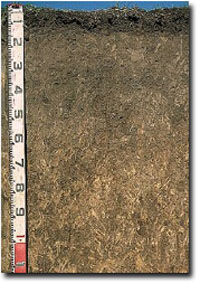 Site GP74 Profile |
| A11 | 7-30 cm | Dark brown (7.5YR3/2); fine sandy clay loam; moderate coarse polyhedral structure; very firm consistence dry; pH 4.8: | |
| A12 | 30-50 cm | Dark brown (7.5YR3/2); fine sandy clay loam; weak coarse prismatic, parting to moderate coarse blocky structure; very firm consistence dry; pH 5.7: | |
| Subsoil | |||
| B21 | 50-100 cm | Brown (7.5YR4/4) with strong brown (7.5YR5/6) mottles; light medium clay; moderate coarse prismatic, parting to strong coarse blocky structure; strong consistence dry; some dark magnesium staining present; pH 6.1: | |
| B22 | 100-140 cm | Brown (7.5YR5/4) with strong brown (7.5YR5/8) mottles; sandy clay; pH 7.4: | |
| B23 | 140+ cm | Light brown (7.5YR6/4) with strong brown (7.5YR4/6) mottles; sandy clay. | |
Key Profile Features:
- Lack of strong texture contrast between surface (A) horizons and subsoil (B21) horizon.
Soil Profile Characteristics:
Horizon | pH | Salinity Rating | ||
Surface (A1 horizon) | Very Strongly Acid | High | Non-Sodic | None1 |
Subsoil (B21 horizon) | Slightly Acid | Low | Non-Sodic | None2 |
Deeper subsoil (at 90 cm) | Slightly Alkaline | Low-Moderate | __ | __ |
2 Strong dispersion after remoulding.
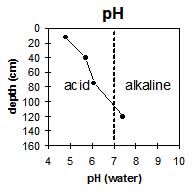 | 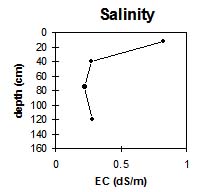 | 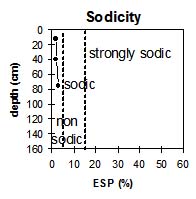 | 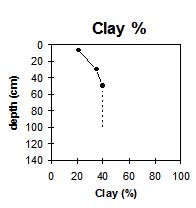 |
The surface is very strongly acid. The upper subsoil is slightly acid becoming slightly alkaline at 110 cm. | The surface salinity rating is high to very high. The subsoil is low becoming moderate at depth. | The surface and upper subsoil is non-sodic. | The clay content increases slightly with depth. |
Horizon | Horizon Depth (cm) | pH (water) | pH (CaCl2) | EC 1:5 | NaCl % | Exchangeable Cations | |||
Ca | Mg | K | Na | ||||||
meq/100g | |||||||||
A0 | 0-7 | ||||||||
A11 | 7-30 | 4.8 | 4.4 | 0.82 | <0.03 | 6.4 | 2.3 | 2.3 | 0.2 |
A12 | 30-50 | 5.7 | 4.9 | 0.27 | <0.03 | 4.8 | 2 | 1.9 | 0.1 |
B21 | 50-100 | 6.1 | 5.4 | 0.22 | <0.03 | 2.9 | 2.3 | 2.5 | 0.37 |
B22 | 100-140 | 7.4 | 6.7 | 0.28 | <0.03 | ||||
B23 | 140+ | ||||||||
Horizon | Horizon Depth (cm) | Exchangeable Aluminium mg/kg | Exchangeable Acidity meq/100g | Wilting Point pF2.5 | Wilting Point pF4.2 | Coarse Sand (0.2-2.0 mm) | Fine Sand (0.02-0.2 mm) | Silt (0.002-0.02 mm) | Clay (<0.002 mm) |
A0 | 0-7 | 11 | 27 | 25 | 20 | 21 | |||
A11 | 7-30 | <10 | 10 | 27 | 22 | 15 | 35 | ||
A12 | 30-50 | <10 | 6 | 12 | 24 | 16 | 21 | 40 | |
B21 | 50-100 | <10 | 4.3 | ||||||
B22 | 100-140 | ||||||||
B23 | 140+ |
Surface (A) Horizons
- The surface soil is strongly acid. This indicates that aluminium and manganese toxicity may occur. However, the level of exchangeable aluminium measured for this pit site is quite low (<10 mg/kg) and unlikely to restrict the growth of aluminium sensitive species. A pH/aluminium test is, however, best performed from samples taken across the paddock and bulked together. Other factors also need to be considered before lime is recommended (e.g. pasture species grown, method of application, local trial responses, soil surface structure and likely cost/benefit).
- Manganese toxicity may also occur particularly in poorly drained situations (as waterlogging may bring manganese into solution).
- Deficiencies of molybdenum and phosphorus may also occur in the strongly acid surface soil. Increasing soil pH by lime application should enable phosphorus (from superphosphate) and molybdenum to become more available. If lime is required, and pH is increased, then the availability of major nutrients should improve.
- The surface (A1) horizon is non-sodic but disperses slightly after remoulding. This indicates that tillage or over-stocking of the soil whilst in a moist to wet condition may result in some structural degradation (e.g. surface sealing, increased cloddiness) occurring. Raindrop action on bare soil may have a similar effect, so it is important to maintain surface cover.
- The level of soluble salts in the surface is moderate and may restrict the growth of salt sensitive species. These levels may be unnaturally high due to the effects of the dry season.
- The inherent fertility of the surface (A1) horizon (based on the sum of the exchangeable calcium, magnesium and potassium cations) is moderate. The high levels of organic matter at this site are important for improving soil fertility, water holding capacity and enhancing surface soil structure.
- Nitrogen levels are high reflecting the high organic matter levels.
- The subsoil has a relatively low inherent fertility throughout (based on the sum of the exchangeable basic cations).


